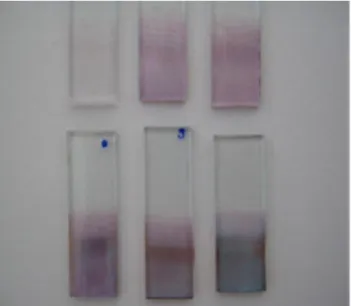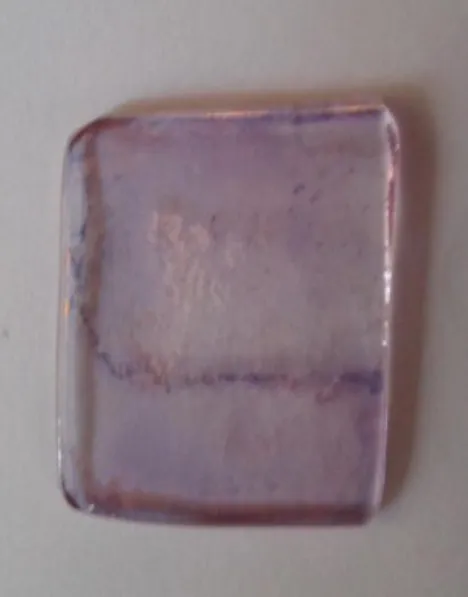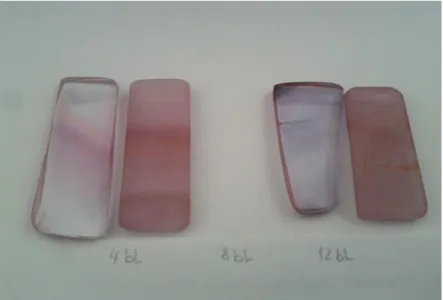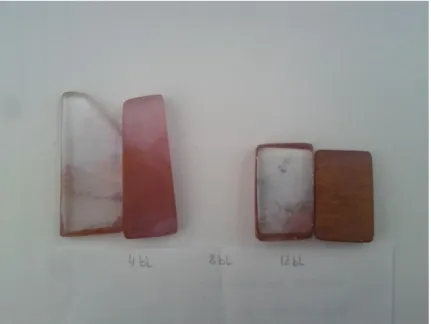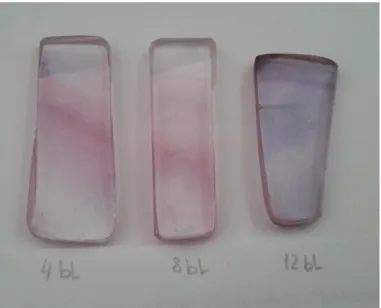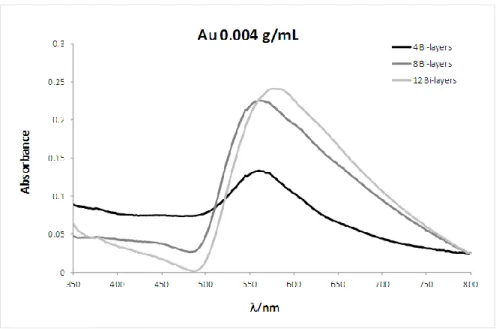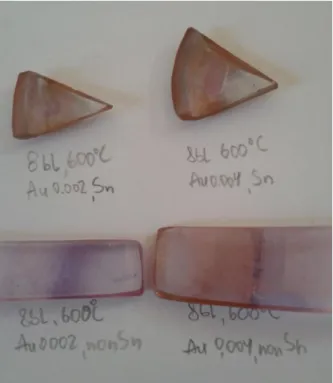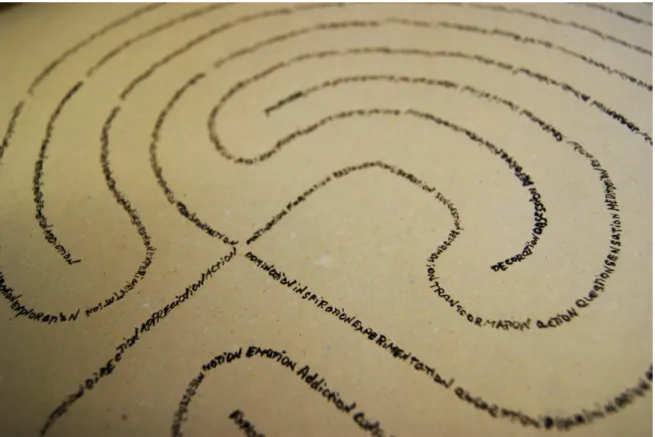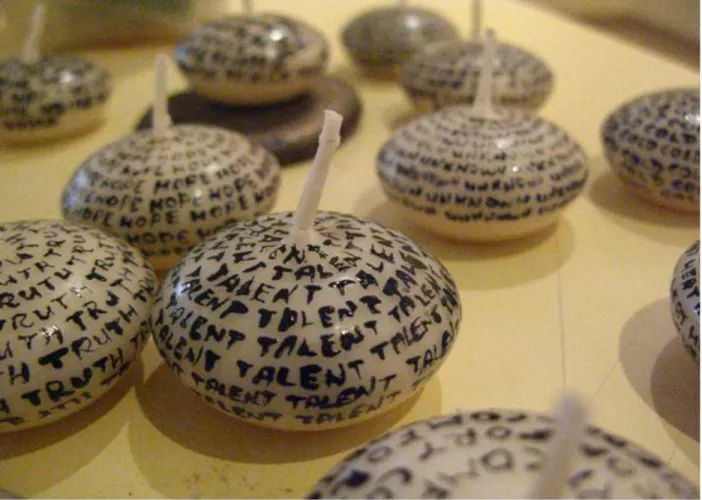Daria Krasilnikova
Master of Glass Art and Science Faculdade de Ciêcias e Technologias
Universidade Nova de Lisboa
UNTITLED:
CONNECTING LAYERS OF CONFUSION, SENSATION AND
TRANSFORMATION
Dissertação para obtenção do Grau de Mestre em Arte e Ciência do Vidro
Orientador(a): Master Robert Christopher Wiley III, Researcher, Vicarte, Unidade de Investigação “Vidro e Cerâmica para as Artes, Faculdade de Ciências e Technologia da Universidade Nova de Lisboa
Co-orientador(a): Doutor Márcia Martins Gonçalves Marção Ventura, Pos-doc
Researcher, Faculdade de Ciências e Technologia da Universidade Nova de Lisboa
Júri:
Presidente: Doctor Márcia Gomes Vilarigues, Assistant Professor, Faculdade de Ciências e Technologia da Universidade Nova de Lisboa
Arguente(s): Doctor César António Tonicha Laia, Researcher, Faculdade de Ciências e Technologia da Universidade Nova de Lisboa
Doctor Teresa Maria de Castro Almeida, Invited Assistant Professor, Faculdade de Belas Artes da Universidade do Porto
UNTITLED: CONNECTING LAYERS OF CONFUSION, SENSATION AND TRANSFORMATION
ACKNOWLEDGEMENTS
I would like to thank my parents Zhanna Krasilnikova and Vladimir Krasilnikov for love, help and the support they are giving me. My brother Alexey Krasilnikov for the wise advises and consultations no matter in what situations he is. My grandmother. The research unit VICARTE. My colleagues on the “Orbital 9”. Tara Woudenberg for the constant guidance and inspiration. Richard Meitner, Michael Taylor and Visiting artist for the opportunity of the new experience. Marcia Ventura for the help and patience towards my scientific knowledge. Robert Wiley for believing in me and sharing the precious knowledge. Diana Martins for the constant help with my life in Portugal. Professor Rui da Silva from IST/ITN (Instituto Tecnológico e Nuclear), Instituto Superior Técnico, Universidade Técnica de Lisboa for the Ion Implantation
experiments. Ana Maria Alonso Martins for unlimited help and support even across
the borders.
ABSTRACT
I believe that glass is a higher substance than most materials. It is a material reflecting humanity. For me, glass is at once a symbolic personification of human beings and at once a state of complete confusion. It is hard to work with. You either have to be talented or patient in order to pass through all the challenges to achieve the highest point of development and harmony. It is like working to be in balance with the material. At times I see it as my own reflection. Maybe I was chosen to be here. Glass making is at some point its own philosophical school, with its systems and meditation, with the training and frustration. It is its own world, its own orbital where we are spinning. Some are closer to the core and some are farther away, but working with glass demands that we all go through the layers to get to the core. It is not maybe as straight as we might hope and doesn’t quite fit the scientific rules. Glass seems to me to be a labyrinth with a goal of the 8th chakra, being a Master in glass making.
Two years ago I chose to move to Portugal and work with glass. Looking at all the wonderful glass hand-made objects around me gave me a sense of excitement. I could not believe that I would be able to do the same. The strong desire to achieve new techniques left me excited while at the same time confused and frustrated. That feeling carried with me through the whole time of the program. The state of confusion, insecurity in my skills, and possibilities were constantly changing. But it never disappeared.
I now propose to explain my personal transformation, layer by layer, as I also work to explain how a young lady from Russia meets glass art and glass science, and attempts to understand their interactions.
In this work colored glass was produced using the gold nanoparticles and the layer by layer deposition of polyelectrolytes through dip coating in order to apply it to artworks that use glass as a medium. Gold was used aiming to obtain a range of colors from purple to blue. The gold nanoparticles were applied to a glass by immersing samples with previously applied multilayers films with polyelectrolytes. A chosen temperature was used both for reduction and fixation of the nanoparticles
into the glass. Attention was focused on the influence of used temperature during thermal treatment for color fixation. Furthermore, several experiments took place in order to clarify the efficiency of applying texture to the sample with the purpose of color fixation. The effect of variables such as the number of polyelectrolytes multilayers and metal solution concentration on the resulting color was also studied. As a potential reducing agent of metals such as gold, the tin element can have influenced on the nanoparticles formation process. An experiment was performed in two samples of soda-lime glass on the surface of which tin was implanted. The influence of tin implantation on the final color of the sample was determined. The samples were characterized using UV-Visible absorption spectroscopy.
The intention was to producecolored glass samples and apply it to the artwork using the “Occhi” technique. After the experiments the direction for the artwork has been changed and the new results achieved.
Keywords: Glass, layers, art, labyrinth, confusion, sensation, transformation, untitled, temple, Layer by Layer, LBL, path, cell, gold nanoparticles.
RESUMO
O vidro é na minha opinião um material de qualidade superior quando comparado com a maioria dos materiais. É um material que reflecte humanidade. Para mim o vidro é a personificação simbólica do ser humano e simultaneamente um estado de confusão absoluta. É difícil trabalhar o vidro. Requer talento ou paciência para contornar todos os desafios e atingir o ponto mais elevado de desenvolvimento e harmonia. Assemelha-se a um equilíbrio entre quem trabalha e o material
trabalhado. Por vezes vejo-o como o reflexo da minha própria imagem. Talvez eu tenha sido escolhida para estar aqui. O “fazer vidro” é até certo ponto uma escola com métodos e pensamentos próprios. É um mundo próprio, uma órbita sobre a qual nos propomos girar. Alguns mais próximos do núcleo enquanto outros se
distanciam, mas trabalhar o vidro exige que todos sigamos layer by layer até atingir o núcleo. O caminho pode não ser em linha recta como esperaríamos e não se
adequar às regras científicas. O vidro surge como um labirinto cuja finalidade será atingir o “8º chakra”, ou seja tornar-me Mestre do fabrico de vidro.
Há dois anos atrás escolhi Portugal para viver e trabalhar com vidro. Observar à minha volta todos aqueles admiráveis objectos de vidro de fabrico manual causou-me uma sensação de entusiasmo. Não queria acreditar que seria capaz de vir a fazer o mesmo. O forte desejo de conseguir novas técnicas deixava-me entusiasmada e ao mesmo tempo confusa e frustrada. Esse sentimento acompanhou-me ao longo de todo o tempo. O estado de confusão e a insegurança nas minhas capacidades alteravam-se constantemente, contudo nunca desapareceram.
Proponho-me agora explicar a minha transformação pessoal, layer by layer, e ao mesmo tempo esclarecer como uma jovem oriunda da Rússia encara a arte e ciência do vidro e a tentativa de compreender as suas interacções.
Neste trabalho o vidro de cor foi produzido usando nanopartículas de ouro e a deposição de polielectrólitos, layer by layer, através de dip coating. Foi usado ouro no intuito de conseguir uma variedade de cores entre o roxo e o azul. As partículas de ouro foram aplicadas submergindo amostras de vidro às quais foram previamente aplicadas múltiplas películas com polielectrólitos. Foi usada uma temperatura que permitisse quer a redução quer a fixação das nanopartículas no vidro.
Foi dada particular atenção à influência da temperatura usada durante o tratamento térmico para fixação da cor. Além disso, realizaram-se várias experiências para se perceber a eficiência da textura aplicada à amostra tendo em vista a fixação da cor. Foi também estudado o efeito de variáveis, tais como o número de multicamadas de polielectrólitos e a concentração do metal na solução, para o resultado da cor. A introdução de estanho, como potencial agente redutor de metais como o ouro, pode ter influenciado o processo de formação de nanopartículas. Foi realizada uma
experiência com duas amostras de vidro sódico-cálcico sobre as quais se colocou estanho. Conseguiu-se determinar a influência da introdução de estanho na cor final da amostra. As amostras foram caracterizadas utilizando espectroscopia de absorção UV.
O objectivo era produzir amostras de vidro colorido e aplicá-las a objectos de arte usando a técnica “Occhi”. Após as experiências alterou-se o sentido do trabalho e alcançaram-se novos resultados.
Palavras-chave: Vidro, camadas, arte, labirinto, confusão, sensação, transformação, sem título, templo, Camada por Camada, caminho, célula, nanopartículas de ouro
FIGURE INDEX
Figure 1: Image of float glass samples with different number of bi-layers, thermal
treatment of 700 :C for 5h. A.1
Figure 2: Picture of clear glass samples thermal treated at 500 :C and 525 :C for 1
hour; 8bl; Au 0.002 g/ml, 0.004 g/ml. A.1
Figure 3: Image of clear glass sample. Thermal treatment using 700 :C; 6bl; Au 0.002
g/ml. A.2
Figure 4: Image of clear glass sample. Thermal treatment using 600 :C; 6bl; Au 0.002
g/ml. A.2
Figure 5: Picture of clear glass sample and sample with texture using 600 :C for 5h;
8bl; Au 0.004 g/ml. A.2
Figure 6a: Picture of clear glass samples and samples with texture using 600 :C for
1h; 4bl, 12bl; Au 0.002 g/ml. A.3
Figure 6b: UV-Visible spectra of samples of clear glass and glass with texture using
600 :C for 1h; 4bl, 12bl; Au 0.002 g/ml. A.3
Figure 7a: Picture of clear glass and samples with texture using 600 :C for 1 hour;
4bl, 12bl; Au 0.004 g/ml. A.4
Figure 7b: UV-Visible Spectra of clear glass and samples with texture using 600 :C for
1 hour; 4bl, 12bl; Au 0.004 g/ml. A.4
Figure 8a: Picture of the clear glass samples using 600 :C for 1 hour; 4bl, 8bl, 12bl; Au
0.002 g/ml. A.5
Figure 8b: UV-Visible spectra of samples of clear glass using 600 :C for 1 hour; 4bl,
8bl, 12bl; Au 0.002 g/ml. A.5
Figure 9a: Picture of clear glass samples using 600 :C for 1 hour; 4bl, 8bl, 12bl; Au
Figure 9b: UV-Visible spectra of clear glass samples using 600 :C for 1 hour; 4bl, 8 bl,
12bl; Au 0.004 g/ml. A.6
Figure 10a: Clear glass samples using 600 :C; 8bl; Au 0.002 g/ml, 0.004 g/ml; two of
the samples have Sn. A.7
Figure 10b: The Rutherford Backscattering (RBS) spectra of the sample submitted to
Sn⁺ ion implantation and aluminum reference sample. A.7
Figure 11: Blown object using samples of LBL method; 8bl; Au 0.002 g/ml, 0.004
g/ml. A.8
Figure 12: The image of Labyrinth comprised of 50 words which reflect feelings
about glass. A.9
Figures 13a and 13b: Image of candles. A.10
Figure 14: Picture of “The Temple of Harmony” exhibition. A.11
Figure 15: Image of the barrier for the entrance with candles. A.12
Figure 16a: Image of The tubes. A.13
Figure 16b: Image of The tubes hanging next to the ceiling. A.14
Figure 17: Picture of the floor. A.15
TABLE OF CONTENTS
ACKNOWLEDGEMENTS ... i
ABSTRACT ... ii
RESUMO ... iv
FIGURE INDEX ... vi
TABLE OF CONTENTS ... viii
INTRODUCTION ... 1
RESEARCH ON GOLD NANOPARTICLES ... 4
EXPERIMENTAL DESIGN ... 6
RESULTS AND DISCUSSION ... 8
PATHFINDING ... 12
CONCLUSIONS ... 15
REFERENCES ... 19
BIBLIOGRAPHY ... 21 FIGURES AND TABLES ... A.1 APPENDIX ... 47A.16
INTRODUCTION
The new world of glass making was a study of two disciplines: Art and Science, and the goals were to either look at those disciplines as a one or to define their separation. Exploring glass science became as important for me as exploring the glass art making and I was always more secure when partaking in scientific research. The goals in science were clear. This was my first evidence of how I would come to see the relationship between art and science. The route chosen for science research was focused on the Layer by Layer polyelectrolyte deposition technique. Many experiments were made and the results will be described later in this paper.
Each person is a unit of life, a peculiar life cell [1]. Through ones life, this cell is covered by many layers of information which are gathered over previous layers. This process is much like the process of gathering layers of hot glass on a blowpipe. It is always hard to tell how many layers will be collected during a lifetime or how many layers one is supposed to have. It does not depend on lifespan. For instance, someone may experience more profound incidents during childhood than during adult life. It depends more on experience. Experience actually affects the life cell and makes the information layers. Parents and close family members are destined to be the first to influence our personality and thus they provide the first layers. Their efforts influence us through our childhood. Later, we are brought to a new system: kindergarten, school, college, university. Then we start to gather information over our previous layers. It does not matter if this old information came from bad decisions or from the right choices; it sticks there and it makes us grow.
In every culture there are those who question, there are those who attempt to expand their cell or to try and be immersed in another system, changing the surrounding cell. Questioning brings great discoveries, but at the same time it damages the “safe cell”, the familiar atmosphere the person lived in. This brings with it a feeling of confusion and being lost. It is a feeling of being unsafe. It is at this point one feels they should urgently look for a replacement for the cell, for familiarity and harmony in this new discomfort. It is painful and uncomfortable.
New sensations, confusion and transformation are some of the million things that I felt as I worked to make sense of art and science in glass. There was no place to hide and there was no one to help me as this was a personal journey. The changes happened as soon as the question appeared, as soon as the thought of the “cell” appeared in the mind. Fortunately or unfortunately there was no way back. The transformation had started. My senses became sharpened, and all of a sudden there were new sensations in my life. This was exciting but it also felt as if denial would be protective. It was pretty much like trying to run backwards to the familiar cell, which was mostly destroyed.
We grab at memories, places or people, until shortly we question again, and we try to expand it again. Possibly it is some sort of masochism; a self torture, it is highly painful but addictive. It is not the pain that is addictive, but the sensation of possibilities waiting ahead.
After two years of emotional torture I could not look anymore to the past. In the end it became important to build something to hold on to in THIS time line.
Seeking answers I began a study of my personal confusion, cultural transformation, the expansion of my personal cell and I have tried to connect these ideas with glass making in order to create art work.
Year 2011 I started with the experiments on glass coloration using the Layer by layer polyelectrolyte deposition technique and as a part of my thesis research I wanted to work with this technique.
During the referred year I was researching the possibilities of coloring borosilicate glass and float glass. With the borosilicate glass I could not come up with positive results, but with float glass it was possible to obtain an intense blue color (Figure 1) and after achieving such results I wanted to explore this technique more.
I was also interested in glassblowing and I wanted it to be a major part of my work, so according to the experience with LBL method one of the techniques I intended to try and combine it with the technique used in glassblowing called “Occhi”.
In this technique, similar sized thin squares of glass are arranged in rows on a metal plate and fused in a glory hole1 and afterward picked up as a single of glass [2]. From there, the glass can be hot sculpted into a desired shape or blown using a blowpipe. Additionally, it is possible to add layers of hot glass to the constructed sheet.
I began by making experiments with the furnace glass melted in VICARTE. [3] Thus, I entered into a dual natured study of my personal experience and the science behind the layer-by-layer deposition technique in glass in order to better understand my relationship with the new world around me.
1
Glory Hole – The opening of the furnace used to keep the glass hot and workable.
RESEARCH ON GOLD NANOPARTICLES
The use of precious metals nanoparticles dates from at least the 4th and 5th centuries BC in Egypt and China for the coloration of several materials including ceramics and glass. The possibility to color glass with metal nanoparticles using thin films is an important subject in glass industry because of its advantages over other coloring techniques. The latest techniques, using plate glass float lines are commercially expensive. The required pigment must be temperature stable and fed directly into the glass-forming mix at the furnace (1400°C), achieving the right tone of color on the production line takes several tons of glass and waiting for the pigment/dye to fade from the glass furnace mix also takes several tons of glass, therefore making the whole process very commercially expensive and time consuming [4].
The most common techniques in current use for applying thin film coatings on glass include conventional atmospheric pressure chemical vapour deposition and sputtering techniques [4].
For the formation of thin films with highly defined structural order, as well as composition and thickness one of the most adaptable techniques is the layer-by-layer (LBL) deposition of polyelectrolytes [5]. The nanoparticles are synthesized in situ using the functional groups of the polyelectrolytes as biding centers of the metals precursors. The process consists mainly in three steps [5, 6, 7, 8]:
1) The film formation by the alternate deposition of oppositely charged polyelectrolyte layers on the substrate;
2) The film immersion in a solution containing metals which are the precursors of the nanoparticles for its incorporation inside the film;
3)The reduction of the metals which can be done by physical or chemical processes. In this process parameters such as the pH used during films assembly or during the loading of the metals can be tested in order to optimize coloration. On the other
hand the temperature has an important role on the reduction as well as on the fixation process of the metals into the glass hence focus should be given to the thermal treatment effects on the coloration of the glass. The number of layers used to produce the film is a way to control the concentration of the nanoparticles and consequently an additional way to control the final coloration. The Sn element which is present in one of the sides of commercial float glasses, is a potential reducing agent of metals such as Au, Ag and Cu and therefore may also have an influence in the colouration. Reproducing the float glass surface through the Sn implantation in soda-lime glass samples can be a way of understanding and control the influence of the element on final coloration. The Sn ions can be introduced into the glass through ion implantation which consists of a ballistic process: the ions gain energy – e.g. through acceleration in an electrostatic field – and are directed and impinge onto the material, within which they interact with the native ions and electrons, thereby loosing energy and momentum, until coming to a stop. The ions thus get incorporated or implanted in the material, from which they cannot easily escape. Being a non-equilibrium technique it allows the implantation of virtually any ion into any material, overcoming the limitations imposed by thermodynamics of mixing, of alloying or even of compounds formation. [9]
EXPERIMENTAL DESIGN
Materials and Methods
Reagents
Polyethylenimin (PEI), branched, avg MW ~ 25,000 by LS (Aldrich), Poly (acrylic acid) (PAA) MW ~ 1,250,000 (Aldrich),
Tetrachloroauric acid (HAuCl₄) hydrate (Fluka, puriss. p.a. ≥49% Au)
Glass samples
Soda-lime glass composition (mol%) - SiO₂ 74.42%, Na₂CO₃ 12.9%, CaO 11.27%. [10] Tg2= 520–600 °C
Texture was applied to the clear glass samples by grinding the surface on both sides of the sample using the diamond blade.
Tin implementation on glass
Incorporation of Sn in the soda-lime glass was made through ion implantation with
nominal 1.0×10;⁶cm⁻<Sn⁺ions of 100 keV energy. The spectra obtained by
Rutherford Back-scattering Spectrometry from the glass and reference (aluminum)
samples implanted with Sn are presented in the figures section. From those spectra
the amount of Sn retained in the glass was calculated as 0.7×10;⁶cm⁻<.
Colored Samples Preparation
Glass Samples were cleaned by immersing in a piranha solution (4:2 mixture of H₂SO₄ and H₂O₂) for 40 min at 90 °C and then rinsed with copious amounts of water and dried using compressed air. The multilayer films were then prepared by immersion of the substrate into PEI (1mg/ml, pH=3.5) and PAA (1mg/ml, pH=3.5) for 20 min each until the desired number of layers was achieved. The films were carefully washed with water after each dipping step and then air dried.
2
Application of gold.
The prepared samples containing PEI and PAA multilayer films were immersed in HAuCl₄ solution with pH=2 and concentrations of 0.002g/ml and 0.004g/ml for 20 min.
The thermal treatment in order to fix the nanoparticles into the glass was performed in air at different temperatures between 500 °C and 700 °C in a Barracha kiln E-6 model.
Samples characterization
The coloration of the glass was evaluated through UV-Visible Spectrometry. UV-Vis absorption spectra were measured with a Varian-Cary 100 Bio spectrophotometer.
RESULTS AND DISCUSSION
1 Influence of the temperature
As a part of the experiment it was necessary to use temperatures above the glass Tg
to fix the color on the glass surface. In this way the glass surface is slightly fused promoting the metals diffusion into the glass matrix. On the other side, the glass deformation promoted through the high temperatures should be avoided. During the experiments thermal treatments at the temperatures 500 °C, 525 °C, 600 °C and 700 °C were attempted.
Using thermal treatment at 500 °C and 525 °C it was not possible to fix any color. After a cleaning process using paper and water most of the color disappeared. (Figure 2)
With the thermal treatment of 700 °C the deformation of the sample occurred (Figure 3). It was not possible to use this temperature for the further experiments. After thermal treatment at 600 °C there was not observed any deformation and it was possible to obtain the slight pink color (Figure 4). Despite the observed loss of intensity, the color of samples treated using these conditions remained fixed after cleaning with paper, water or a nitric acid solution (3M). The temperature value of 600 °C was chosen for the further experiments.
At 600 °C but with a longer thermal treatment time (5h) the same intensity and coloration on the glass were obtained and there were no visible improvements of the color fixation (Figure 5).
2 Influence of texture
Uv-visible spectra of samples containing different number of bi-layers, with one hour of thermal treatment at 600 °C using gold solutions with concentrations 0.002g/ml and 0.004g/ml are presented in Figures 6b and 7b. For different amounts of bi-layers, one sample of clear glass and one sample with applied texture were used.
In the Figures 6a and 7a it is possible to observe that the textured samples have more homogeneous and intense color.
The higher intensity of color is also observed on the UV-Visible spectra through the higher absorbency peaks. For the higher concentration, the textured sample with 12 bi-layers has a strong metallic color film on the surface, a fact that can refer to the high amount of gold ions on the glass surface which were agglomerated and reduced into metallic gold.
Applied texture gives an opportunity to better fixation of nanoparticles. Ions of gold have more chance to diffuse into glass.
3 Influence of number of bi-layers and gold solution concentration
Uv-visible spectra of samples containing different number of bi-layers, with one hour of thermal treatment, at 600 °C using gold solutions with concentrations 0.002g/ml and 0.004g/ml are presented in Figures 8b and 9b. The samples with higher number of bi-layers have higher absorbance values. With the increased number of bi-layers it is possible to see a shift to the higher wavelength value. The color intensity changes with the increasing amount of bi-layers, which is related to the higher concentration of metal that is loaded in the films (Figure 8a and 9a). On the other side, the higher concentrations of the metal loaded on a higher number of bi-layers can promote the nanoparticles agglomeration which is responsible for the observed shifts to the higher wavelengths. In this case a change of color tonality more to the blue is promoted.
Increasing the gold solution concentration exerts the same effects mentioned above: a higher intensity of color and a shift to the higher wavelength values.
4 Experiments with Tin
When present in the glass matrix, the tin element can act as a reducing agent for gold and other metals. The objective of this experiment was to determine if we can have larger nanoparticles and a consequent shift to the higher wavelength value when promoting the reduction of metal in order to get a blue color tone.
In Figure 10a we can see the difference between samples with and without tin.
A comparison was made between samples with the same amount of bi-layers, same concentration of gold and thermal treated at the same temperature.
A more intense golden layer can be observed on the implemented samples, this is a fact that can be attributed to a more efficient reduction of gold. Nevertheless it was not possible to achieve a blue color tone.
In sum, with the LBL method it was possible to obtain color on clear glass with the temperature of 600 °C. It was impossible to fix a color with thermal treatment using a temperature below 600 °C. Finally, it was not possible to use a temperature higher than (700 °C) because of the visible deformation of glass samples.
The stronger color fixation appears to happen with the samples which contain texture. The more successful result for artwork could be obtained with previously textured samples using the thermal treatment temperature around 600 °C. The intensity and tone of the color depends on the amount of bi-layers and the used concentration of gold.
The tin implantation seems to improve the gold reduction, but it did not help to obtain a blue color.
The experiments suggested the possibility of obtaining a more visible blue color using different conditions. However, it is necessary to use much higher concentration of gold, and as such, financial limitations made this process cost prohibitive.
In the end, I found that it was not possible to use the samples to produce my artwork as the conditions I intended to apply were not corresponding with the successful results.
As at first my intention was to apply the glass samples in a hot sculpture, I decided to use a technique called “Occhi”, in spite of the lack of the desired blue color. During furnace working, the amount of time the samples spent at high temperature resulted in extreme color loss (Figure 11).
After the annealing and cooling process the final result was an object that had only a slight pink color. Based on the time intensive process in LBL deposition and the lack of satisfactory color result while furnace working, it was decided that a change in directions was needed in order to make art.
PATHFINDING
Based on my experimental results with the LBL process, I found that I was going to need to take the next step in my process in a completely new direction. This new direction began to take form as I concentrated on images of labyrinths. To begin, I started to make my own labyrinth comprised of 50 words which reflect my feelings about glass. I was making it in different variations until I was satisfied with the image I had created and I realized that it was a direct reflection of what I feel (Figure 12). And after that I decided to use that image as a main element in my thesis work.
I also felt that I needed to experience this image in large scale. For me, placing it on a wall would make sense and right after that I have decided to use this labyrinth as a point of departure to build a sort of temple. It is hard to fully explain why a temple. I saw the space in the library where students from the first year had to make their show and the “image” just came into my mind. Pictures of different temples from all over the world started to fill my mind. The information of different religions collected after years of education at the university in Moscow and the experience of my life in China came together in one new idea. These experiences fit together like pieces of a puzzle, and I imagined a place where I would feel secure and inspired. This would come to be my “space”, the space in which I could reflect my inner space. In the end, the Temple was becoming the formal idea that I was being drawn toward for my show. The feeling of somewhat a secure loneliness and harmony was corresponding with the idea of my own temple, and to build it I had to start to work with meaningful elements for me at that moment. The gallery space I worked with was a big challenge for me. It was my first real experience in placing my work in front of people from such different backgrounds. They would come and judge, either me or my work, and not everything that existed in my mind should come to fruition in that space. I faced that problem as if i had to build a temple from the beginning: the basement, walls. As it was my "home" and might become "home" for somebody else. First, I did not want to use the light that was available in the exhibition space. These were standard halogen track lights and they offered nothing in the way of connecting with the idea of a temple.
As such, I chose to use candles. As I chose to build my own physical culture I concentrated on elements that would make me feel more comfortable and perhaps happier. I was overwhelmed with different feelings and not all of them were positive. Any temple or cathedral for me is a small island where one can hide from fears and negative things which surround us in life. In some cultures people write wishes on the paper and burn them or make a wish by pronouncing it inside their mind and light or blowout a candle. Different cultures have their own ways. I chose to burn out fears by writing them on a candle and letting them go away, acting as a sort of cleansing. Also, I decided to make wishes and write them on candles so they might fill the space of the temple and come true. I wrote different words and made the candles to also act as a sort of guide. These were prepared by painting words and text them (Figure 13a, 13b). As a next step I had to place my image of a labyrinth on the wall in the center of the gallery space. Because of the limitations of the space, I was unable to write out my word labyrinth directly on the wall. You may remember that scale was an important factor for me in realizing the labyrinth. So, I decided that I had to shape my 50 words on canvas. The result was a size of about 2m by 2.80 m. ( Figure 14)
For the “entrance” into the temple I chose to use 10 blown black “Russian dolls” and hot sculpted “glass stones”. These became a type of low barrier in order to divide the space into two zones. One would be the outside world and the other would be the inner world of the temple. To also add to this idea of distinguishing the temple space, the low area of the entrance was lit with candles. (Figure 15)
Also for the entrance I made blown tubes which were hanging from above and capped with cork. Inside the hand made tubes were dried peas, plant springs, and paper with selected words from the Quran3. (Figure 16)
On the floor of the temple I placed three pillows made of packs of dried peas. The remaining area of the “temple” floor covered in a thin layer with dried peas. In Russia, we have a tradition of kneeling on the peas in a sort of punishment or
3
The Quran, is the central religious text of Islam, which Muslims consider the verbatim word of God.
torture, so I hoped to express that feeling of the hard floor and perhaps an almost painful discomfort in the atmosphere. (Figure 17)
I imagined that if I created a temple as a piece of my “religion”, it would allow me to concentrate on the things I am interested in. It would allow me to find harmony inside myself and to find where I am at in my artistic journey.
If I created rules, my culture would become flexible according to my capabilities and requirements. I made my temple as a place of silence and harmony. Thus my spirit was affected positively by cultural factors and psychological factors both. Personal, emotional, and intellectual harmony was the primary motivation.
CONCLUSIONS
When a person is confused, he can make unexpected decisions, he can change his life path absolutely, not judging by his own preferences, acting impulsively. This can be a catalyst for development. When a person is frustrated, he doesn't move, he just stands at the turn of the continuation of his life. One must have an impulse to move forward.
Firstly I made a decision for myself to involve science experiments in my art work. I had been working in the science laboratory in order to achieve solid results with layer-by-layer so as to produce art. It became an obsessive disorder in my mind, trying to design the work I wanted because I believed the results of my experiments had to be there.
Being constantly stuck inside my mind, I thought building and designing the object which would be a reflection of my personal opinion on Science and Art was my goal. Finally, I came to a point where I had to show the results of my work. Confusion was all I could define of the feelings I had. Still, I had to find the way to connect science and art. I wanted to prove to myself it was possible. But no matter how much I tried to merge the two parts together they would always come apart for me. I could only be honest and finally share my confusion and face my fear. After that I started to search my own feelings. I realized that my main work is me, my feelings and reactions about it and my own reflections.
Now I don’t think it is necessary to put forth a question about how to marry art and science. It confused and misled me. Maybe they, art and science are two sides of the same coin. Perhaps they just can’t face each other.
The way I pictured my confusion, at least to make it clear for me, was a labyrinth. I started to look deep inside the history of labyrinths. In the images I found one shape constantly repeating in the different articles from different parts of the world. This stood out strongly enough for me to hold on it.
For me the life path of every person is a labyrinth itself. A person follows the life path and actually tries to find the way out. God makes the path complicated and gives us choices - where to turn, where to go. There are several ways out of the labyrinth and there are a lot of dead ends. A person does not know which way is better. One has simply to make some choice. If we find any success we believe we are making the right choice. However, every turn shapes and modifies us. But if we think, “What if we made a different choice and followed another path and it is not a dead end?” Then we believe that the possible choice was perhaps a better one. We are not sure if the other path was not a dead end, but we consider it wrong automatically. Imagine the other path changes your life absolutely, offers you another system of values, and you are happy as quite another man.
But what if our life is written, what if there are those major important points where we absolutely have to arrive, and the length of the road is chosen by us. Some cultures or religions say that the child was given by God. So, the child has now a starting point, an entrance to the labyrinth of life. And there are a lot of turns at every stage, until maybe you reach a, lets say, “resting point” where there is an event you had to come to no matter which of the paths is taken. It is from there that we might move forward on a new path. I think the Labyrinth works this way; we take up choices, we turn and develop another life path. These philosophical problems began to arise for me as I worked to link art and science. I felt as if I were on some sort of path.
In Hindu tradition The Seven Turn Labyrinth connects people with the sacred knowledge, meditation, and spiritual transformation [11]. Others would connect the image of the labyrinth with the universal plan of God which a person has to follow on his or her Life`s path [12]. Passing through the circles (paths) you will achieve a sacred knowledge which was always open to you. But, if you have never been taking all the responsibility to open your mind to that possibility, it remains a frustrating existence.
Science became a circular labyrinth which I had to take in the beginning in order to go forward. Looking for positive results was my mistake.
In science any results are positive, either it is working or not, the most important fact is the knowledge. You either make changes during the work or realize that during the experiment you could not achieve goals you were looking for. But it is about the experience. The results of the science experiments covered my cell with the new layer and instead of letting me use it as a material it forced me to stop and look at myself.
In the cell what is important is not the initial culture or religion, but the individual at the core of it. The search is happening throughout our lifetimes; through our experience we fill our cell. The culture ones lives in, the religions studied, the techniques tried are like new protective layers, walls of the new cell. And as it expands we find new interests to build new walls. This constant change, observation, and new growth were the things I was being led toward. More important was to understand the results of the experiment of Master of glass Art and Science and not the polyelectrolyte deposition.
In the end, I believe I am trying to heal my confusion using some sort of the spiritual energy in order to create an inner harmony, but I have also tried to create an allusion to the feeling I am getting through the healing process. My spiritual energy is at the top and it allows my impressions to fulfill the cultural cell that I create. This new cell makes me concentrate on performing and my spirit is constantly recharged.
If my temple is a piece of culture, I shall use it positively. I shall use it to concentrate on work that is necessary for me at the moment. I shall use it as an inspiration or the starting point for new discoveries. This new cell, arriving from my temple’s construction is not the last statement, it is not the result of my previous experiences, it is a starting point for new ones.
It is an understanding that this newly constructed cell will expand more with more time. If I use this art work, this temple has the power to reopen my intellect and make it work for my requirements. When I am in the temple, I can experience harmony.
I still find it highly positive that the science research led me through the labyrinth and in the end showed me another possibility of how I can work. I was highly interested in exploring the Layer By Layer technique and felt like I could not stop, I wanted to find out more about it, but the time of the master is limited. I still think that the research of the soda-lime glass using LBL method could go forward and maybe in future it would be possible to obtain blue color using different criteria. In the end, I think that perhaps there is not a direct or visible influence of science on my artwork, but it definitely opened new doors inside my mind and let me grow. Now I can look at the world around me and see more than just objects. Science and art can exist together in a person. Maybe just not how I imagined they would.
REFERENCES
[1] Thomas Alva Edison, Diary and Sundry Observations of Thomas Alva Edison, New York, Philosophical Library, 1948
[2]Clearly Inspired: Contemporary Glass and Its Origins, Pomegranate Communications, Inc. 1999
[3] VICARTE – Research Unit “Glass and Ceramics for the Arts”
[4] Walters, G., Parkin, I.P., 2009. The incorporation of noble metal nanoparticles into host matrix thin films: synthesis, characterisation and applications. Journal of Materials Chemistry, 19, 574;
[5] Decher G., 1997. Fuzzy Nanoassemblies: Toward Layered Polymeric Multicomposites. Science 277, 1232 ;
[6] Shang L., Jin, L., Guo, S., Zhai, J., Dong, S., 2010. A Facile and Controllable Strategy to Synthetise Au-Ag Alloy Nanoparticles within Polyelectrolyte Multilayer Nanoreactors upon Thermal Reduction. Langmuir, 26, 6713;
[7] Chia, K.K., Cohen, R.E., Rubner, M.F., 2008. Amine-Rich Polyelectrolyte Multilayer Nanoreactors for in Situ Gold Nanoparticles Synthesis. Chemical Materials, 20, 6756;
[8] Wang, T.C., Rubner, M.F., Cohen, R.E., 2002. Polyelectrolyte Multilayer Nanoreactors for Preparing Silver Nanoparticle Composites: Controlling Metal Concentration and Nanoparticle Size. Langmuir, 18, 3370;
[9] Nastasi, M., Mayer, J., Hirvonen, J.K., 2004. Ion-Solid Interactions: Fundamentals
and Applications. Trade paperback, Cambridge University Press.
[10] www.glassproperties.com/glasses/
[11] Soros, George, Soros on Soros: staying ahead of the curve. Published by John Wiley and Sons, Inc., 1995
[12] Sig Lonegren, Labyrinths, Ancient Myths and Modern Uses, Gothic Image Publication
[13] The Holy Qur'ān, Worldsworth Editions Limited,2000
BIBLIOGRAPHY
I. Narayanan,Vasudha. "The Hindu Tradition". In A Concise Introduction to World Religions, ed. Willard G. Oxtoby and Alan F. Segal. New York: Oxford University Press, 2007
II. Ven. Dr. W. Rahula, “Bodhisattva Ideal in Buddhism”, "Gems of Buddhist Wisdom", Buddhist Missionary Society, Kuala Lumpur, Malaysia, 1996
III. Kenneth I. Pargament. The meaning of spiritual transformation. In Joan D. Koss-Chioino & Philip Hefner (Eds.), Spiritual transformation and healing: Anthropological, theological, neuroscientific, and clinical perspectives, Walnut Creek, CA: AltaMira Press, 2006
IV. Raymond F. Paloutzian. Religious conversion and spiritual transformation: A meaning-system analysis. In Raymond F. Paloutzian & Crystal L. Park (Eds.), Handbook of the psychology of religion and spirituality, New York: Guilford, 2005 V. Robinson, James. Religions of the World: Hinduism. 1st. Chelsea House Publishers, 2004. s, 1996
VI. Paul Auster “The Art of Hunger: Essays, Prefaces, Interviews, The Red Notebook”, Penguin 1997
VII. Jill Purce “The Mystic Spiral: Journey of the Soul”, Avon, 1974
VIII. Drunvalo Melchizedek “The Ancient Secret of the Flower of Life”, Light Technology Publications, 1999
IX. Rob Lilwall “Cycling Home from Siberia”, Hodder Pb, 2009
X. George Soros “Soros on Soros: staying ahead of the curve”. Published by John Wiley and Sons, Inc., 1995
XI. Sig Lonegren "Labyrinths, Ancient Myths and Modern Uses", Gothic Image Publication, 2007
FIGURES AND TABLES
Figure 1. Float glass. Different number of bi-layers; thermal treatment of 700 oC for 5 h.
Figure 2. Picture of clear glass samples thermal treated at 500 oC and 525 oC for 1 hour; 8bl; Au 0.002 g/ml, 0.004 g/ml.
Figure 3. Clear glass sample using 700 oC; 6bl; Figure 4. Clear glass sample using 600 oC; 6bl; Au 0.002 g/ml. Au 0.002 g/ml.
Figure 5. Picture of clear glass sample and sample with texture using 600 oC for 5 hours; 8bl; Au 0.004 g/ml.
Figure 6a. Picture of the clear glass samples and samples with texture using 600 oC for 1 hour; 4bl, 12bl; Au 0.002 g/ml.
Figure 6b. UV-Visible spectra of samples of clear glass and glass with texture using 600 oC for 1 hour; 4bl, 12bl; Au 0.002 g/ml.
Figure 7a. Picture of clear glass and samples with texture using 600 oC for 1 hour; 4bl, 12bl; Au 0.004 g/ml.
Figure 7b. UV-Visible Spectra of clear glass and samples with texture using 600 oC for 1 hour; 4bl, 12bl; Au 0.004 g/ml.
Figure 8a. Picture of the clear glass samples using 600 oC for 1 hour; 4bl, 8bl, 12bl; Au 0.002 g/ml.
Figure 9a. Picture of clear glass samples using 600 oC for 1 hour; 4bl, 8bl, 12bl; Au 0.004 g/ml.
Figure 10a. Clear glass samples using 600 oC; 8bl; Au 0.002 g/ml, 0.004 g/ml; two of the samples have Sn.
Figure 10b. The Rutherford Backscattering (RBS) spectra of the sample submitted to Sn+ ion implantation and aluminum reference sample.
Figure 11. Blown object using samples of LBL method; 8bl; Au 0.002 g/ml, 0.004 g/ml.
Figure 12. The Labyrinth.
Figure 13a. The Candles.
Figure 13b. The candle with floating letters.
Figure 14. The Temple of Harmony.
Figure 15. The barrier for the entrance with candles.
Figure 16a. The tubes.
Figure 16b. The tubes hanging next to the ceiling.
APPENDIX
Canvas
Preparation of canvas
The fabric 290x200cm, purchased at the Leroy Merlin, was painted in white through 5 steps: 1) layer of paint “interior primario aquoso branco” mixed with water. 2) layer of paint using 75% of “interior primario aquoso branco” and 25% of “Gesso Primer 1001” and water. 3) layer of both kinds of paint 50%x50% adding water. 4) layer of both kinds of paint 25x75%, adding water. 5) Layer of “Gesso primer 1001” adding water.
Drawing
The drawing was made using black “indian ink”. Candles
The different sized candles were purchased at IKEA. The text was written on the candles using acrylic black paint.
Candlesticks
Were blown at the Vicarte hotshop, using black powder from Friedrich Farbglasshutte Kugler Colors.
The Entrance
Bottom part
The flat stones were made using black Kugler powder. The dolls were blown using black Kugler powder.
Top part: the tubes
Clear blown tubes were made at the Vicarte hotshop. Capped with the collected previously cork from the wine bottles.
Tubes contained dry peace, found plant and the paper with the writing in Arabic language from Quran, pronounced as Bismillah ir-Rahman ir-Rahim, the common translation: "In the name of God, most Gracious, most Merciful". [13]
The floor
The floor of the gallery space was covered with split dried piece and cardamom seeds. Also on the floor were made “pillows”, squares made using packages of dried piece. 4 packs for one pillow. 8 pillows in total.
